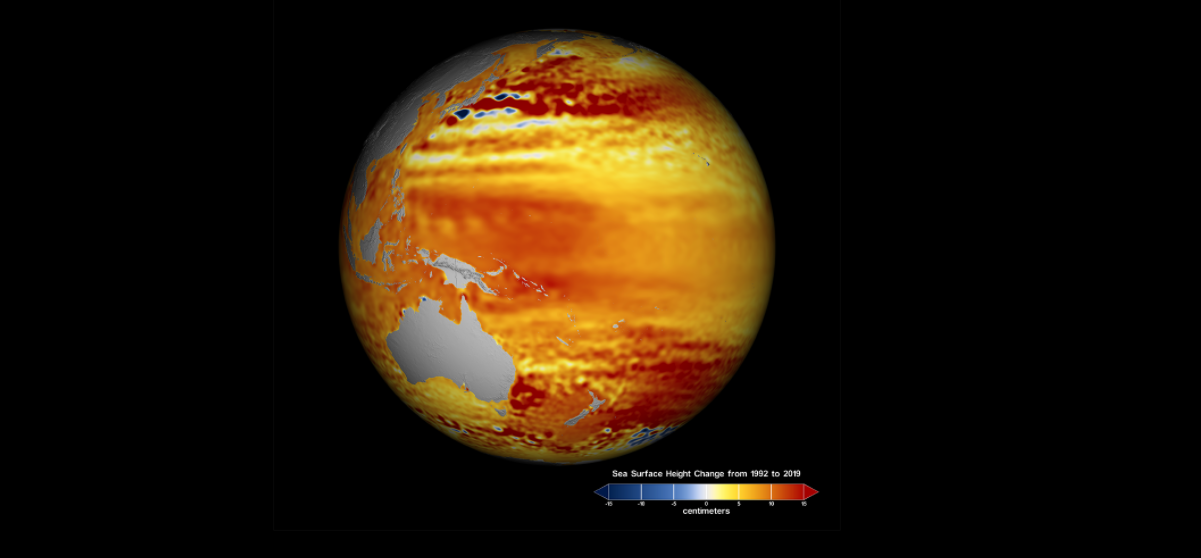
Something about describing a lunar cycle that influences tide levels as “moon wobbles” sounded tantalizing enough to flood the recent news cycle for a few days. Yet, if it takes a tipsy moon — a phenomenon known for centuries — to bring attention to climate science and evolving understanding of sea level rise impacts, it could help engage the public in supporting efforts to mitigate the worst effects.
The article published in a recent issue of Nature Climate Change found traction because of the wobble, despite it being a normal part of the moon’s nodal orbit, a nearly two-decade cycle where the moon’s orbital plane intersects with Earth’s orbit at two spots called nodes.
Supporter Spotlight
“Yes, this moon wobble is certainly not a new thing. It’s always been there — the moon drives changes in our tides on a wide range of timescales,” Benjamin Hamlington with NASA’s Jet Propulsion Laboratory in Southern California and a co-author of the paper, said in an interview. What is new, according to the paper, is the effect that the wobble has on the moon’s gravitational pull, and consequently the tides, in combination with rising sea levels.

Anyone living near an ocean or sound is already familiar with tides — low tide, high tide, neap tide, spring tide, sound tide, king tide, moon tide — which result from certain orientations of the moon and sun relative to the Earth.
In recent years, nuisance flooding, often called sunny-day flooding, is commonly used to describe high tide inundation that frequently occurs, even in the absence of storms. According to a July press release about the research, the National Oceanic and Atmospheric Administration reported more than 600 sunny-day flood events in 2019.
“Coastal locations around the United States, particularly along the Atlantic coast, are experiencing recurrent flooding at high tide,” the paper said.
But as seas continue to rise, high-tide flooding will eventually reach a tipping point that results in rapid increase in the frequency of those events, the paper continued. And that is where the gravitational pull of the wobbling moon comes into play.
Supporter Spotlight
“The study assesses a wide range of variabilities — the ups and downs that occur from year to year, the natural cycles in the ocean,” Hamlington told Coastal Review.
Hamlington explained that the natural variabilities, once a nonissue, are now viewed by scientists as a looming problem.
“Because of the long-term sea level rise and the ongoing sea level rise, we’ve seen that variability that wasn’t a problem previously is going to be a problem in the future,” he said.
Led by the members of the NASA Sea Level Change Science Team from the University of Hawaii, the study is the first to account for all known oceanic and astronomical causes for flooding, the press release said. The researchers collected data from 89 tide gauge locations in every coastal U.S. state and territory but Alaska.
“The important part of this study is really just putting as many of the pieces together as possible,” said Hamlington, who is also the leader of NASA’s Sea Level Change Team, “then assess how coastal flooding is going to work in the coming decades.” By “pieces,” he elaborated, he means natural processes that cause sea level to change: tides, seasonal ocean cycles, heating and warming, in addition to the background, long-term global warming that is underway.
As part of the 18.6-year lunar nodal cycle, the moon orbits around the Earth on a plane that is tilted about 5 degrees relative to the Earth’s orbit around the sun, known as the ecliptic plane. When the moon intersects with Earth’s orbit at the two nodes, it wobbles. Hamlington compared it to what happens with a spinning coin as it slows just before it falls flat.
“It does this very slow wobble over time,” he said. “And that positioning, that orientation relative to Earth’s orbit, causes a shift in the tidal amplitude.”
Although the wobble is imperceptible to people, what is important is that when the moon is on the lower part of the wobble, it pulls the tides down with it, meaning that high tide would be lower. Then when it moves to the higher part of the wobble, it will do the reverse — pull the high tide higher than usual.
The current moon cycle is moving toward the downward part of the cycle, but it is still amplifying tide. Even so, sea levels are not so high now on most U.S. coasts that high tides regularly top flooding thresholds. But that’s not expected to be the case when the cycle moves back again to amplifying in the mid-2030s. What the scientists found in the recent research is that the moon wobble will be moving back to its higher position, unfortunately, just as sea levels are ready to spill over the metaphorical rim of the bathtub.
Translation: in about a decade, coastal areas will start experiencing higher high tides, on top of higher seas, meaning more beach erosion, more tidal flooding and higher water tables. Over the years, as current trends are going, more and more coastlines will see increased days of high tides.
“So, we’re just so close to this threshold of flooding in these coastal locations that a near-term push — any near-term push — is going to get you into flooding conditions more frequently,” Hamlington said. “And then it happens to be one of the nearest-term pushes is going to be from this new wobble or lunar nodal cycle.”
Tides have always been different on different coastlines and at different places on each coastline. By determining the timing and effect of the moon wobble on high tides — “modulations of tidal amplitude” — researchers have combined that data with the tidal predictions at different coastal locations to calculate the period in coming decades where the flooding threshold will be reached.
“The mid-2030s, in particular, may see the onset of rapid increases in the frequency of HTF in multiple US coastal regions,” the paper said. “We also show how annual cycles and sea-level anomalies lead to extreme seasons or months during which many days of high-tide flooding (HTF) cluster together. Clustering can lead to critical frequencies of HTF occurring during monthly or seasonal periods one to two decades prior to being expected on an annual basis.”
Scientists can only give a range in predicting the level of rising seas in 2100, Hamlington said. But tide cycles can be predicted. And as sea levels continue to rise, he said, flooding will occur even with lower high tides.
“So as long as we keep increasing that foundation, more and more types of seasonal cycles and signals that we see in the ocean are going to cause flooding to occur,” he said.
Under moderate sea level rise projections, for instance, the inflection — the tipping point, so to speak — in Wilmington is the year 2036.
“And that’s going to be an additional 85 days of flooding a year,” Hamlington said, adding it’s about four times more than what is happening right now.
For the Dare County town of Duck, the year of inflection is 2023.
That means that two years from now, under the minor flood threshold, intermediate sea level scenario, there will be an additional 44 days of high-tide flooding. For the moderate flood threshold, the inflection is 2045, with 48 days of more severe flooding.
Hamlington said that NASA and NOAA, among others in the scientific community, are working on more interagency coordination, with an ultimate goal of communicating the latest findings relevant to climate issues in a clear way that would be accessible to engineers, policy makers, government officials and others, including the public.
Already, in a partnership between NASA and the Intergovernmental Panel on Climate Change, NASA created a tool from IPCC sea level projections that allows easy and user-friendly access to the information for the public, he said.
“I think that it’s important that we, in addition to doing the science research and understanding sea levels, that we also invest in these delivery tools,” Hamlington said.
And as the moon wobble report showed, the public is paying more mind to climate change issues that affect them — once the scientists can get their attention to convey the urgency.
“Low-lying areas near sea level are increasingly at risk and suffering due to the increased flooding, and it will only get worse,” said NASA Administrator Bill Nelson in the press statement.
“The combination of the Moon’s gravitational pull, rising sea levels, and climate change will continue to exacerbate coastal flooding on our coastlines and across the world. NASA’s Sea Level Change Team is providing crucial information so that we can plan, protect, and prevent damage to the environment and people’s livelihoods affected by flooding.”







